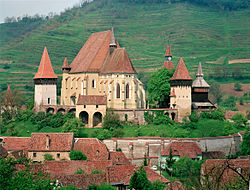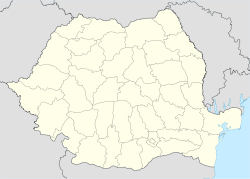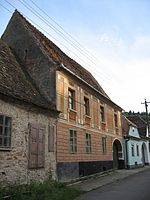- Biertan
-
Biertan
Biyertan— Commune — Biertan and its fortified church Location of Biertan, Sibiu Coordinates: 46°8′23″N 24°31′25″E / 46.13972°N 24.52361°ECoordinates: 46°8′23″N 24°31′25″E / 46.13972°N 24.52361°E Country  Romania
RomaniaCounty Sibiu County Status Commune Founded 1224 (first official record) Government – Mayor Cornel Raţiu (Social Democratic Party) Area – Total 97.26 km2 (37.6 sq mi) Population (2002) – Total 3,002 – Density 3,088/km2 (7,997.9/sq mi) Time zone EET (UTC+2) – Summer (DST) EEST (UTC+3) Postal Code 557045 Website http://www.biertan.ro Biertan (German: Birthälm, Romani: Biyertan, Hungarian: Berethalom) is a commune in central Romania, in the north of the Sibiu County, 80 km north of Sibiu (formerly Hermannstadt in German) and 15 km east of Mediaş. Biertan is one of the most important Saxon villages with fortified churches in Transylvania, having been on the list of UNESCO World Heritage Sites since 1993. It was the see of the Lutheran Evangelical Bishop in Transylvania between 1572 and 1867.
The commune is composed of three villages: Biertan, Copşa Mare (Gross-Kopisch; Nagykapus) and Richiş (Reichesdorf; Riomfalva), each of which has a fortified church.
Contents
History
The first documentary testimony about the village dates from 1283 in a document about the taxes paid by the inhabitants of 7 villages and so it is believed to have been founded sometime between 1224 to 1283 by Transylvanian Saxons. The village settlement quickly developed into an important market town and by 1510 Biertan supported a population of about 5,000 people. Between 1468 and the 16th century a small fortified church (die Kirchenburg) was constructed and developed. After the medieval period the town declined in importance with the rise of neighbouring Sighişoara (formerly Schäßburg in German), Sibiu (Hermannstadt) and Mediaş (Mediasch).
In the census of 1930 Biertan had 2331 inhabitants, of whom 1228 were Transylvanian Saxons. During World War II many men were conscripted into the Romanian army and later the Waffen-SS. After the war many Transylvanian Saxons were expelled from the region. Following the collapse of Communism in 1990 many more left for Germany.
Today the whole commune has a population of about 3,000 and the village of Biertan alone has about 1,600 people. It is one of the most visited villages in Transylvania, being the historically important place of the annual reunion of the Transylvanian Saxons, many of whom now live in Germany.
Demographics
According to the 2002 census, Romanians made up 68.58% of the population, Roma made up 22.23%, Germans made up 4.77% and Hungarians made up 4.40%.[1] The commune of Biertan is officially bilingual, with both Romanian and Romani languages being recognised officially and used in public signage, education, justice and access to public administration.
Image gallery
Famous people
- Artur Phleps, a Biertan-born military career officer. He, uniquely, served in the Habsburg army of Austria-Hungary, the royal army of Romania and finally the Waffen-SS.
- Sara Römischer (This was the former home of Sara Römischer, a long-time resident of Biertan, who died in 2006. Although she was not famous in the traditional sense, her story is representative of that experienced by many Transylvanian Saxons in Biertan following the Second World War. Sara was forcibly deported to Siberia in 1945, on a sunny January day. She survived and after five hard years returned to her hometown of Biertan to bring up her family through many further hardships. Read an English translation of her harrowing story, or for the original German text in Siebenbürgische Zeitung)
See also
Notes
External links
- (German) Informations and pictures about Biertan
- (English) Infos about Biertan
- (English) Impressions of Biertan
- (Romanian) Infos and pictures about Biertan
- Fortified church in Biertan
Sibiu County, Romania Cities 
Towns Agnita · Avrig · Cisnădie · Copşa Mică · Dumbrăveni · Miercurea Sibiului · Ocna Sibiului · Sălişte · Tălmaciu
Communes Alma · Alţâna · Apoldu de Jos · Arpaşu de Jos · Aţel · Axente Sever · Bazna · Bârghiş · Biertan · Blăjel · Boiţa · Brateiu · Brădeni · Bruiu · Chirpăr · Cârţa · Cârţişoara · Cristian · Dârlos · Gura Râului · Hoghilag · Iacobeni · Jina · Laslea · Loamneş · Ludoş · Marpod · Merghindeal · Micăsasa · Mihăileni · Moşna · Nocrich · Orlat · Păuca · Poiana Sibiului · Poplaca · Porumbacu de Jos · Racoviţa · Răşinari · Râu Sadului · Roşia · Sadu · Slimnic · Şeica Mare · Şeica Mică · Şelimbăr · Şura Mare · Şura Mică · Tilişca · Târnava · Turnu Roşu · Valea Viilor · Vurpăr
Categories:- World Heritage Sites in Romania
- Communes in Sibiu County
- Fortified churches
- Medieval architecture
- Gothic architecture in Romania
Wikimedia Foundation. 2010.








